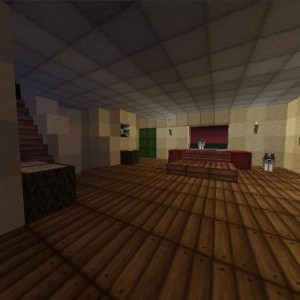Last week, my good friend’s younger sister posted a recreation of her childhood home (their parents recently sold their house in Northern Virginia and moved to another state), complete with the family pets–two dogs–in their respective favorite spots:
I was reminded of this post during this week’s readings, specifically (for obvious reasons) the essays on The New Aesthetic…
At work in this recreation isn’t a grand artistic or philosophical statement, S— made this because she was homesick. She’s just started her second year in college and when she does go “home”, it will not resemble her home at all. This Minecraft house renders the once-physical, completely digital in order to preserve those physical memories. In the comments, her sister noted the importance of the dogs in their right places as if this was a photograph recalling an actual event rather than a crude digital rendering. She’s pressed this software into the service of rebuilding her childhood home because the actual, physical house has been written over by its new owners and inhabitants. The result, comforting to S—, her sister, and friends, is also a little disquieting when examined. The perspective is off so the room appears larger (and colder) than it was and the image’s brightness and color palette re-imagine a living room I’ve been in as austere and uninviting. Something of the uniqueness of place is missing in this rendition (it’s aura removed by digital reproduction?)
Bruce Sterling is right when he says that machines can’t really do all the sensory perceiving we metaphorically ascribe to them. They are not the sentient, moral actors of science fiction. And we don’t, as Alex already pointed out (and Hayles goes on about in the reading last week), have a language to accommodate screens and coding within an ongoing critical, literary history that centers on (physical) pages and text. Sterling’s argument here seems to focused on the machine and not, even though he discusses our “friendship”, human interaction with the machine. It’s the cybernetic relationship built in that interaction that forces the increased blurring of the physical and digital. In this way, New Aesthetics isn’t about “making it new”, it’s about recognizing that increasingly fluid interplay and being OK with it.
Both Sterling and Ian Bogost seem to want New Aesthetics to be more than what it is currently. In their essays, both men call for a more bold “true” metaphysics: Bogost wants an a twentieth century style manifesto and Sterling, similarly, wants to move beyond the aggregation of objects, and “digital scrapbooking.” Brindle et al may eventually do both. But that doesn’t make sense here and in this medium. It seems to me that to force newness and singular vision onto this aesthetic would undermine it. For the time being, The New Aesthetics functions like this Minecraft house: reconsidering the old and familiar through the filter of the digital and shifting the focus from the separation of these two spheres.
